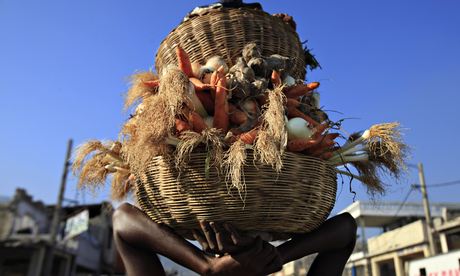
A Mumbai shoeshine boy who dreams of becoming a chef, a Malagasy fishing village struggling to adapt to changing seas and a vegetable garden that is helping Port-au-Prince recover from the trauma of the 2010 earthquake are among the diverse subjects of a series of films made to celebrate imaginative approaches to overcoming hunger, disease and poverty.
The Sundance Institute's Short Film Challenge invites independent film-makers from all over the world to submit fictional accounts or documentaries that chronicle innovative solutions to familiar development problems.
Applicants for the project, which is supported by the Bill and Melinda Gates Foundation, have until 1 July to pitch films of between three and eight minutes. The five winning entries will receive a $10,000 (£5,950) grant and have their films shown at the 2015 Sundance film festival.
To kick off the challenge, the institute has funded five pilot films that are being shown at a free screening at the 02 in London on Sunday 27 April.
Ritesh Batra's film, Masterchef, follows Akhil, a shoeshine boy whose chance meeting with a popular TV cook leads him to ponder a life away from the streets.
Batra, who has recently returned to India after years in the US, was keen to make a film that took a sideways look at hunger. "The theme of the programme is hunger, and in India there is no shortage of hunger," he said. "In my work I always struggled to keep the cultural fetishism out; it's really easy to go down that route. I wanted to make something that was about a different kind of hunger, and not be literal."
Food – or rather its lack – is a prominent theme in most of the films. Tod Lending's Vezo, a mix of animation and video, tells the story of a village in Madagascar that was forced to rethink its fishing practices after the growing human population decimated stocks of fish and octopus.
Narrated by a 14-year-old girl, the film aims to give people an idea of the problems facing the community. "They're not going to gain an in-depth knowledge of the subject by looking at this four-and-a-half minute piece," Lending said. "But they are hopefully going to be catalysed to learn more about it and maybe be sensitised to yet another issue that's out there that's important and worth looking at."
For her film, After My Garden Grows, Megan Mylan travelled to west Bengal to see how a micro-agriculture programme for adolescent girls is helping them to resist the pressure to get married young. Its protagonist, Monika, 16, uses the vegetables she grows in her garden to assert her freedom from social convention and expectation.
"Monika's gourds are just gourds; they're not silver bullets – her life is not all wrapped up in a bow at the end of the movie," Mylan said. "But I do think you see the empowerment and I hope you feel a shift in her father's perception of her role in the family."
Kombit, by Jeff Reichert and Farihah Zaman, shows the difference that a community garden has made to those living in the notorious Cité Soleil slum in Port-au-Prince. Not only has the project helped to feed people in the Haitian capital, it has also helped bring them together.
"They're taking this place that's been so poverty-stricken for so long and just doing simple things to not only make themselves healthier, but also to make it more beautiful," Reichert said. "It's obviously not a solution to all the ills of Cité Soleil, but it does make things better."
The most experimental of all the films is Am I Going Too Fast? by Hank Willis Thomas and Christopher Myers, which weaves a digital tapestry of sounds, images and voices to confront stereotypes about Africa and poverty. It skips between lives and livelihoods in Nairobi and Nakuru, Kenya, looking at how mobile-phone banking, micro-finance and individual creativity have transformed the cities and those who live in them.
According to Myers, the popular western image of poverty is as stale as it is wrong. "It's static: it's this image of the idle poor and the child standing in the midst of rubble, and we really wanted to challenge that flatness and give a more nuanced and layered idea of what poverty is," he said. "Poverty is a lot of people working very hard; poverty is endless amounts of ingenuity, poverty is structural problems that haven't been addressed, and we wanted to reflect all of that."
The five films will be available to view on the Global development site next week.

